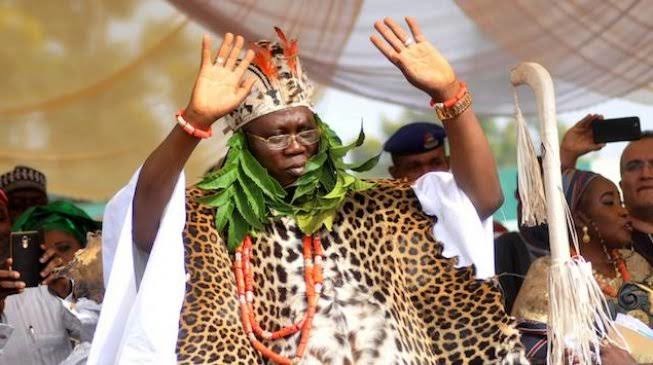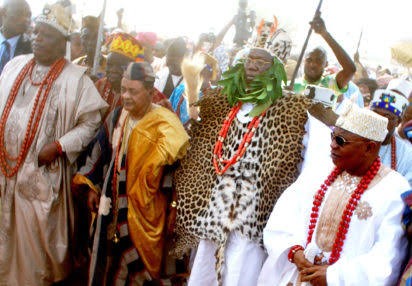
As a lover of history and with bias for my source, the highly revered Oyo Empire, it is time to talk some history. And I am writing this for the purpose of this day; a day you don’t probably witness its like more than once or twice in a lifetime. For some of us, we are lucky to witness it for the second time, while some are witnessing it for the third time. You surely are not unaware of the myths that have surrounded the institution of Aare Ona-Kakanfo due to mysterious circumstances that surrounded the deaths of some of the holders of the title. If the reigns of the earliest Kakanfos were not known to us, at least the reigns and deaths of the past two Aares, or even the past three (for students of history like yours truly) are still very fresh in our memory like a nightmare that prompted one’s premature rise from the bed: Aare Kunrunmi of Ijaye who died in a war he orchestrated himself, Aare Latoosa who died in Kiriji war, Aare Ladoke Akintola who died alongside other Nigerian political big-wigs in the first military coup in Nigeria and very recently (to some of us anyway) Aare MKO Abiola who died in prison while defending his mandate during General Abacha’s Military Junta.
But alas, not all Kakanfos kicked the bucket in mysterious circumstances. There were indeed some Kakanfos who lived and died peacefully, as I shall reveal in this essay. But first, let us make some incursions into the history of the institution of the Aare Onakakanfo and how the title came into existence. Permit me to digress a bit and this is for the records. Let me emphatically state here that throughout the Yoruba nation, only the Alaafin reserves the power to appoint anyone as a chief of Yorubaland, and this shouldn’t be a subject of debate anywhere. During the colonial era, Alaafin was the king that the colonial masters related with on every matter that concerned the Yorubas. Alaafin Alowolodu Adeyemi I in particular, was referred as the king of the Yorubas. It was at his instance that the treaty that ended the Kiriji war was signed. It was he who wrote to Queen Victoria of Britain, Rev. J. B. Wood and Lieut.-Governor W. B. Griffiths in two separate letters asking them to help bring Kiriji war to an end. An excerpt from his letter reads:
“My country has long been disturbed by desultory war, which Your Excellency well knows and which has put a stop to all trade and impoverished the country….”
The final phrase of his letter reads:
“I beg to remain,
ADEYEMI, KING OF THE YORUBAS”
So whatever civilization has brought before our doorsteps now, we have no choice but to accept. But that was the situation then before modernization made many attempts to distort history by turning many natural rulers rebels to their superiors and altogether, vassals of the government. But that is just by the way.
Back to our main business. The title of Aare Onakakanfo was not in existence until the reign of Alaafin Ajagbo who ruled over 700 years ago. Alaafin Ajagbo was one of the greatest Alaafins in history. It was his time the story of Soun Ogunlola of Ogbomoso happened. He wanted a unified host for the whole of Yoruba nation and he created the title of Kakanfo who will be the head of the esos of the Alaafin. The introduction of the title was also informed by the need to fortify the ancient pre-colonial army of the old Oyo Empire which at one time could boast of over 100,000 horsemen. Aare Ona Kakanfo was a title given to the generalissimo, the war general during the old Oyo Empire. The major terms of reference for an Aare Ona Kakanfo were to lead battles, fight wars, mobilize and train “soldiers” and conquer the enemies.
For any individual to be considered for the title, the first criterion was that he must be a warrior of high repute, and the second criterion was that he must not be an indigene or a resident of Oyo. It is after this that other qualities might be considered. The reason for the second criterion is not farfetched: An Aare is a powerful title holder who can easily be equated to any Yoruba oba (not the Alaafin) and whom after his installation will never prostrate for any oba again, including the Alaafin throughout his lifetime. He will rather salute him (Alaafin) and any king he comes across like two warriors will salute each other, by locking their left ankles with each other three times. So, if such a fellow is a direct subject of the Alaafin (who hails or lives in Oyo), how will he not equate himself with his only known superior (Alaafin)?
Alaafin Ajagbo’s mother hailed from Iwere-Ile and the warning he gave at the installation of the first Aare Ona-Kakanfo was that under no condition must Aare wage war against Iwere-Ile. Any Kankanfo who tries it does so at his own peril. Another stern warning Oba Ajagbo gave was that no Kakanfo should wage war or betray against Alaafin who is his benefactor. Doing so will be tantamount to biting the finger that fed the Kakanfo and gruesome end awaits any Kakanfo that tries it. In history, two Kakanfos had made attempts to attack the Alaafin and they ended the way Ajagbo pronounced it. They were Kakanfo Afonja of Ilorin who attacked Alaafin Aole Arogangan, and Kakanfo Kurunmi of Ijaye who attacked Alaafin Adelu Agunloye in this present Oyo settlement.
So Alaafin Ajagbo installed his bosom friend, Kokoro Igangan of Iwoye-Ketu as the first Aare Ona-Kakanfo. Ajagbo’s reign was very long, probably the longest serving Alaafin ever. History has it that he reigned for about 140 years. As earlier said, Alaafin Ajagbo Mogun-n-leti was a very powerful and a warlike king, and he conquered many people in the West, including the Popos and the Sabes(in Benin republic). He destroyed Iweme in Popo country. He is said to have sent four expeditions out at once; under the Basorun, Agbakin, Kankafo, and Asipa. No wonder, he craved a generalissimo for the whole of Yoruba nation.
Kakanfo, as created by Alaafin Ajagbo is akin to a field marshal and is conferred upon the greatest soldier and tactician of the day. ‘By virtue of his office he is to go to war once in 3 years to whatever place the King named, and dead or alive, to return home a victor, or be brought home a corpse within three months (that is no longer the case). Kakanfo usually has certain ensigns: The Ojijiko, and a cap made of the red feathers of the parrots tail, with a projection behind reaching as far down as the waist, an apron of leopards skin, and a leopard skin to sit on always the Asiso or pigtail and the Staff invincible. Most of the Kakanfos have been more or less troublesome, due to the effect of the ingredients they were inoculated with. In war they carry no weapon but a weapon known as the King’s invincible staff.’ It is generally understood that they are to give way to no one not even to the King, their master. Hence, another reason Kakanfos are never created in the capital (Oyo) but in any other town in the Kingdom. There have been a total of fourteen Aare Ona-Kakanfos before now, with Gani Adams making the list up to fifteen. But we will not be able to give details of every of them because not all of them had remarkable histories. We will discuss few of them with notable histories and the circumstances surrounding their deaths. The list of all the Kakanfos till date are as follows:
Kokoro igangan of Iwoye-Ketu,
Oyatope of Iwoye,
Oyabi of Ajase,
Adeta of Jabata,
Oku of Jabata,
Afonja l’aiya l’oko of ilorin,
Toyeje of Ogbomoso,
Edun of Gbogan,
Amepo of Abemo,
Kurumi of Ijaye,
Ojo Aburumaku of Ogbomoso (son of Toyeje)
Latoosa of Ibadan
Ladoke Akintola of Ogbomosho (the premier of western region during the first republic.
MKO Abiola of Abeokuta
And now Ganiyu Abiodun Ige Adams of Arigidi-Akoko

After Kakanfo Kokoro Igangan came Oyatope of Iwoye. No spectacular events were recorded of the first two Kakanfos until the tenure of Oyabi of Ajase whose abode was in Jabata. Kakanfo Oyabi’s tenure was predicated upon the revolt of the Oyo people against the tyranny of Basorun Gaa who executed four Alaafins in quick succession in the 18th century; Oba Labisi, Oba Awonbioju, Oba Agboluaje and Oba Majeogbe were all victims of Gaa’s despotism, oppression and cruelty. Oba Labisi’s case was even the most unfortunate. He was elected to the throne but was not allowed to be crowned. His Basorun, Gaa , conspired against him and killed all his friends. Labisi eventually committed suicide when he could not rule. Gaa remained powerful, long after him; installing kings as he pleased. Alaafin Awonbioju’s tenure was another sorry case; probably the shortest tenure in the history of Alaafinate. He was installed by Gaa, and killed by same when he refused to prostrate for him. He reigned for only 130 days. The case of very handsome Oba Agboluaje was very different as he reigned for years before Gaa killed him and installed Majeogbe. Majeogbe tried to free himself from Gaa and his sons who had also become powerful but his high-handedness amounted to nothing as Gaa also got rid of him. After this an unwilling Abiodun Adegoolu was installed the Alaafin by Gaa. This would at the end become his albatross as the wise Adeegoolu sought solace in Kakanfo Oyabi. The Esos were lead into the city like Caesar did across the Rubicon River and Basorun Gaa was killed by Oyabi. Oyaabi died peacefully.
To be continued…
In the final part, we shall make incursions into the exploits of Kakanfos Afonja of Ilorin, Kunrunmi of Ijaye, Ojo Abaramaku of Ogbomoso, Obadoke Latoosa of Ibadan, Ladoke Akintola of Ogbomoso and Moshood Abiola of Abeokuta.










